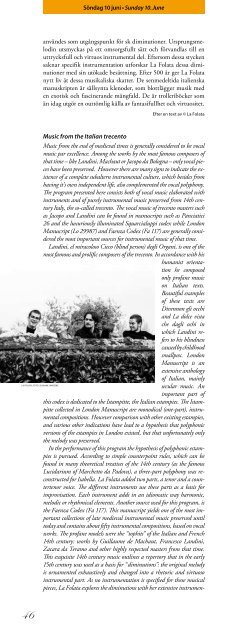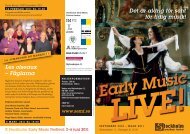festivalprogram - Stockholm Early Music Festival
festivalprogram - Stockholm Early Music Festival
festivalprogram - Stockholm Early Music Festival
Create successful ePaper yourself
Turn your PDF publications into a flip-book with our unique Google optimized e-Paper software.
Söndag 10 juni • Sunday 10. June Söndag 10 juni • Sunday 10. June<br />
användes som utgångspunkt för sk diminutioner. Ursprungsmelodin<br />
utsmyckas på ett omsorgsfullt sätt och förvandlas till en<br />
uttrycksfull och virtuos instrumental del. Eftersom dessa stycken<br />
saknar specifik instrumentation utforskar La Folata dessa diminutioner<br />
med sin utökade besättning. Efter 500 år ger La Folata<br />
nytt liv åt dessa musikaliska skatter. De senmedeltida italienska<br />
manuskripten är sällsynta klenoder, som blottlägger musik med<br />
en exotisk och fascinerande mångfald. De är trolleriböcker som<br />
än idag utgör en outtömlig källa av fantasifullhet och virtuositet.<br />
Efter en text av © La Folata<br />
<strong>Music</strong> from the Italian trecento<br />
<strong>Music</strong> from the end of medieval times is generally considered to be vocal<br />
music par excellence. Among the works by the most famous composers of<br />
that time – like Landini, Machaut or Jacopo da Bologna – only vocal pieces<br />
have been preserved. However there are many signs to indicate the existence<br />
of a complete subaltern instrumental culture, which besides from<br />
having it’s own independent life, also complemented the vocal polyphony.<br />
The program presented here consists both of vocal music elaborated with<br />
instruments and of purely instrumental music preserved from 14th century<br />
Italy, the so-called trecento. The vocal music of trecento masters such<br />
as Jacopo and Landini can be found in manuscripts such as Panciatici<br />
26 and the luxuriously illuminated Squarcialuppi codex while London<br />
Manuscript (Lo 29987) and Faenza Codex (Fa 117) are generally considered<br />
the most important sources for instrumental music of that time.<br />
Landini, el miracoloso Cieco (blind person) degli Organi, is one of the<br />
most famous and prolific composers of the trecento. In accordance with his<br />
humanist orientation<br />
he composed<br />
only profane music<br />
on Italian texts.<br />
Beautiful examples<br />
of these texts are<br />
Divennon gli occhi<br />
and La dolce vista<br />
che dagli ochi in<br />
which Landini refers<br />
to his blindness<br />
caused by childhood<br />
smallpox. London<br />
Manuscript is an<br />
extensive anthology<br />
of Italian, mainly<br />
la folata, foto: susanne janssens<br />
secular music. An<br />
important part of<br />
this codex is dedicated to the Istampitte, the Italian estampies. The Istampitte<br />
collected in London Manuscript are monodical (one-part), instrumental<br />
compositions. However comparison with other existing estampies,<br />
and various other indications have lead to a hypothesis that polyphonic<br />
versions of the estampies in London existed, but that unfortunately only<br />
the melody was preserved.<br />
In the performance of this program the hypothesis of polyphonic estampies<br />
is pursued. According to simple counterpoint rules, which can be<br />
found in many theoretical treatises of the 14th century (as the famous<br />
Lucidarium of Marchetto da Padova), a three-part polyphony was reconstructed<br />
for Isabella. La Folata added two parts, a tenor and a countertenor<br />
voice. The different instruments use these parts as a basis for<br />
improvisation. Each instrument adds in an idiomatic way harmonic,<br />
melodic or rhythmical elements. Another source used for this program, is<br />
the Faenza Codex (Fa 117). This manuscript yields one of the most important<br />
collections of late medieval instrumental music preserved until<br />
today and contains about fifty instrumental compositions, based on vocal<br />
works. The profane models were the “tophits” of the Italian and French<br />
14th century: works by Guillaume de Machaut, Francesco Landini,<br />
Zacara da Teramo and other highly respected masters from that time.<br />
This exquisite 14th century music outlines a repertory that in the early<br />
15th century was used as a basis for “diminutions”: the original melody<br />
is ornamented exhaustively and changed into a rhetoric and virtuoso<br />
instrumental part. As no instrumentation is specified for these musical<br />
pieces, La Folata explores the diminutions with her extensive instrumen-<br />
tarium. A profound knowledge of the grammar of late-medieval music<br />
allows the ensemble to express itself freely in this musical language and<br />
to add elements like self-composed counterparts and improvisation to<br />
the exquisite diminutions. 500 years later, La Folata brings new life to<br />
these musical treasures. The late-medieval Italian manuscripts are rare<br />
jewels that reveal music of an exotic and intriguing complexity. They are<br />
conjuring-books that in medieval times – and even still today - serve as<br />
an inexhaustible source of fantasy and virtuosity.<br />
La Folata<br />
olalla alemàn, sopran • soprano<br />
katelijne lanneau, blockflöjter • recorders<br />
thomas baeté, fiddla • fiddle<br />
wim maeseele, luta • lute<br />
david catalunya, clavesimbalum & orgel • organ<br />
From a text by © La Folata<br />
den medeltida avant-garden<br />
Vid medeltidens slut, en tid av upplysning, frigörelse och humanism,<br />
skapades utrymme för en ny musikalisk form. Med nybyggda<br />
katedraler att framföra verk i utvecklades å ena sidan, i<br />
samklang med den tidens litteratur, dolce stil nuovo och å andra<br />
sidan den överväldigande färgrika gotiska stilen. Denna medeltida<br />
avant-gardemusik innesluts i ensemblen La Folatas repertoar. Fulla<br />
av kreativitet vill ensemblen föra den nutida publiken in i denna<br />
mycket speciella period av den europeiska musikhistorien. För<br />
detta framförande av Ars Nova och Ars Subtilior krävs mycket efterforskningar.<br />
Trots intensiv musikhistorisk forskning de senaste<br />
50 åren saknas ändå mer detaljerad information om denna periods<br />
musikaliska framföranden. La Folata låter sig dock inte hindras av<br />
detta faktum utan låter fantasi och kreativitet överbrygga de luckor<br />
som finns. Med stor stilsäkerhet rekonstrueras partier som saknas.<br />
Denna kombination av kreativ interpretation och musikhistorisk<br />
forskning gör La Folata tolkningar till unika konsertupplevelser.<br />
De senaste åren har ensemblen framgångsrikt medverkat i flera<br />
av de mest prestigefyllda festivalerna i Europa som t ex Brügge,<br />
Antwerpen, Utrecht och Girona. Konserter med ensemblen sänds<br />
regelbundet i de europeiska klassiska radiokanalerna.<br />
Efter en text av © La Folata<br />
<strong>Music</strong> of the medieval avantgarde<br />
The end of the dark ages saw a changing climate, a time of enlightenment,<br />
humanism, cathedrals and emancipated nobles. This changing<br />
climate evolved a new musical repertoire that touched on one hand<br />
the subtle dolce stil nuovo in the literature of the time and on the other<br />
hand the overwhelming flamboyant gothic style. The music from this<br />
age of the “medieval avant-garde” embodies the specific repertoire of<br />
the ensemble La Folata. In a creative, vivid and moving manner the<br />
ensemble approaches this repertoire, introduces it to the contemporary<br />
public and pays hommage to one of the most extraordinary periods of<br />
European musical culture. The performance of the Ars Nova and Ars<br />
Subtilior music demands a great deal of investigation. Despite the<br />
musicological efforts of the last fifty years, there is an lack of specific<br />
information about musical performance in this period. La Folata<br />
however does not conceive this as restrictive, but on the contrary the<br />
lack of concrete information leaves space for the creative fantasy of<br />
today’s performers. La Folata edits and arranges all its repertoire in<br />
a very specific and style-conscious way: from interesting and colourful<br />
instrumentations to reconstructions or even compositions of undocumented<br />
parts. This combination of musicological research and<br />
interpretative creativity makes La Folata’s performances unique.<br />
During recent years La Folata have established a highly successful<br />
musical career: The ensemble has performed in several of the most<br />
prestigious early music festivals of Europe (Bruges, Antwerp, Utrecht,<br />
Barcelona, Girona, Brezice...). Concerts by the ensemble are regularly<br />
broadcasted on classical radio stations throughout Europe.<br />
From a text by © La Folata<br />
46 47<br />
b a



